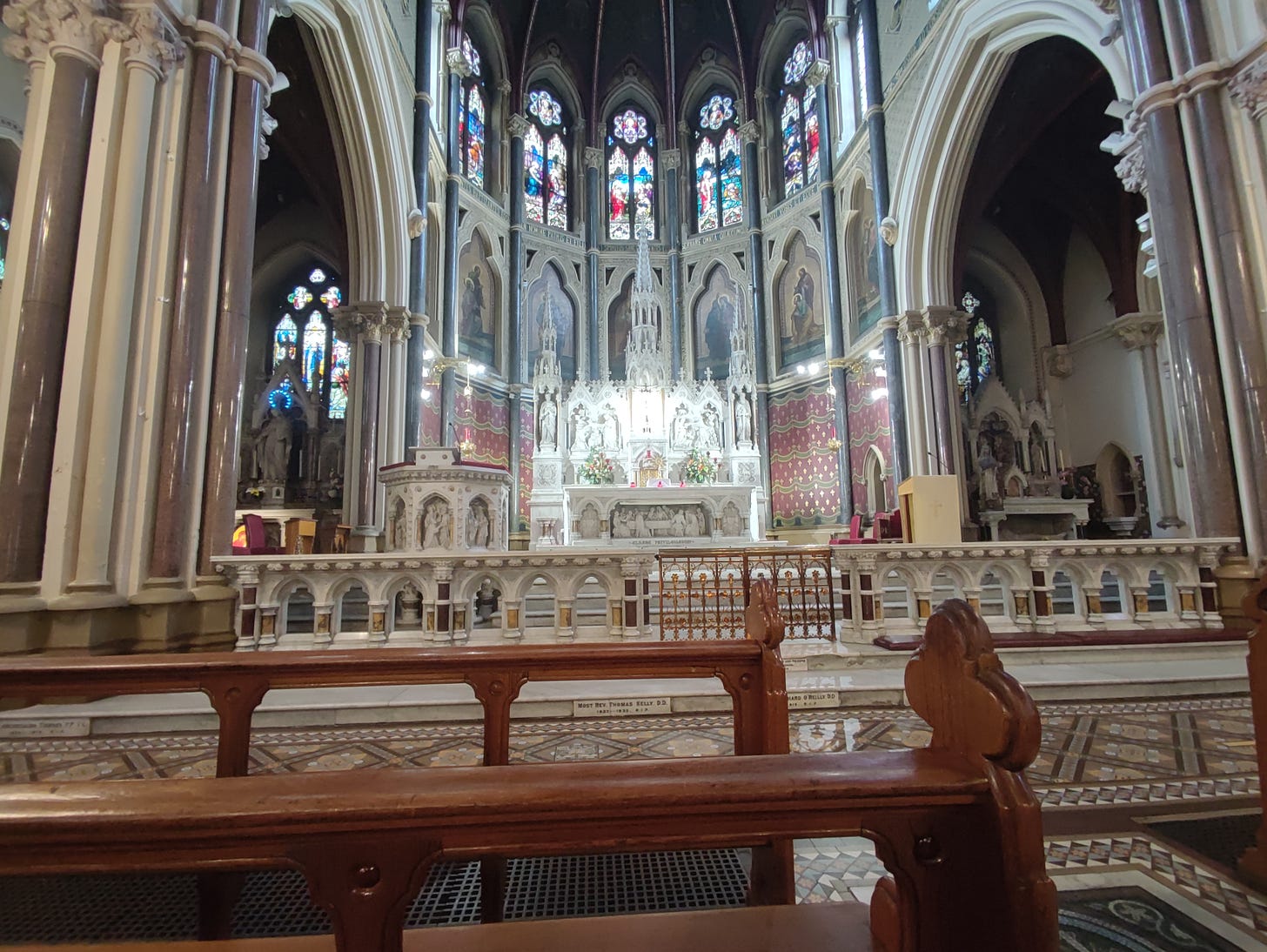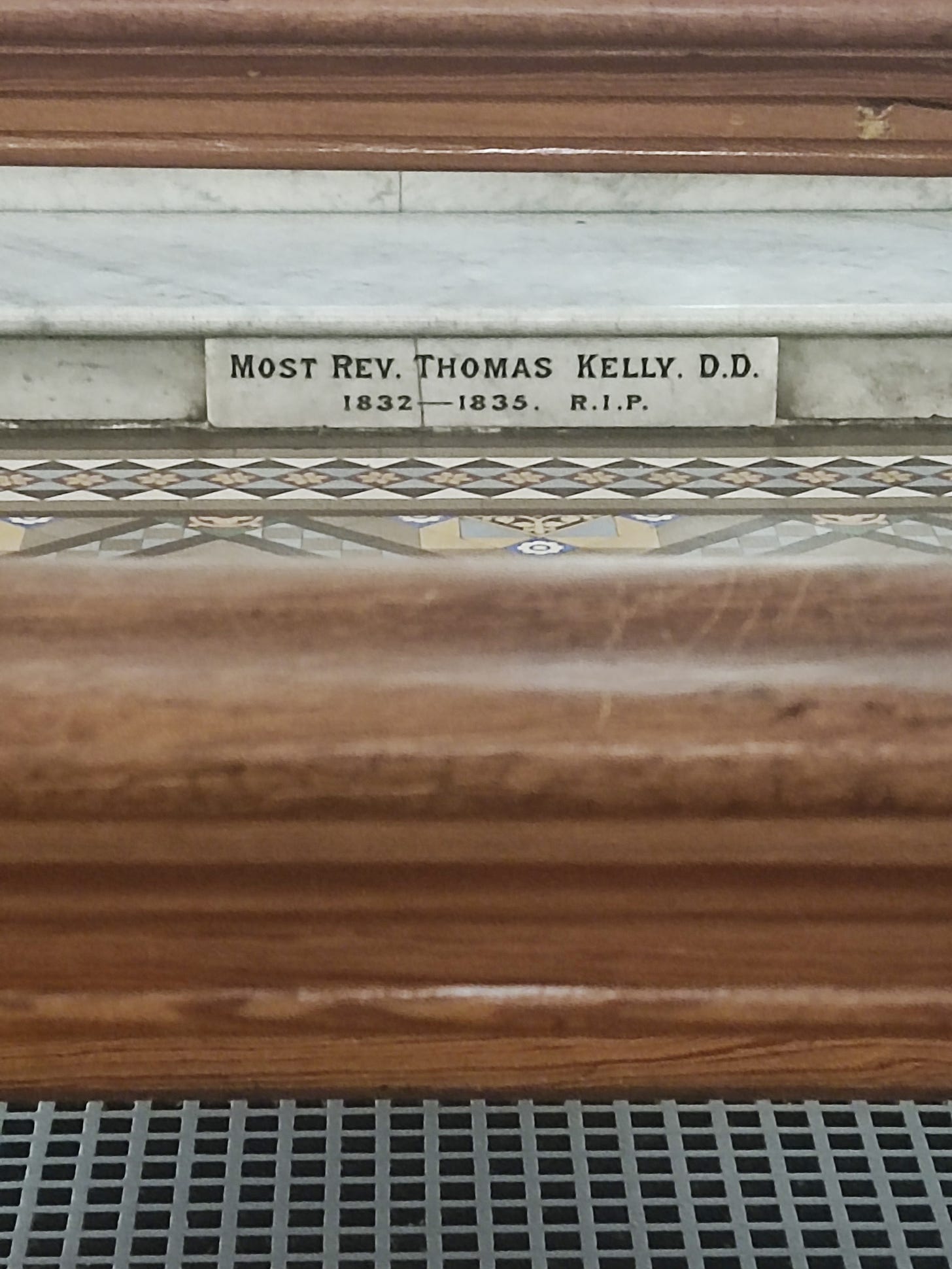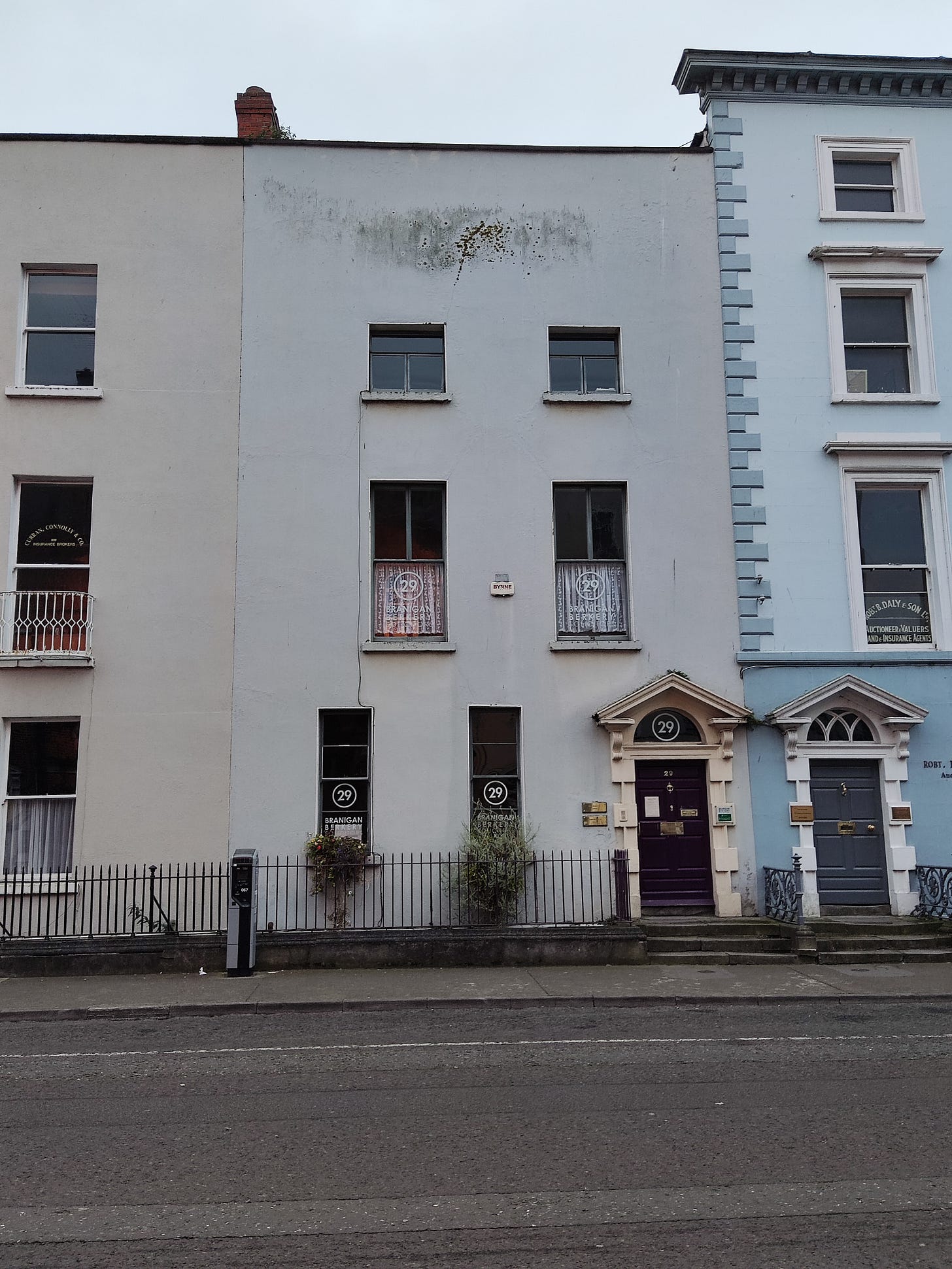Residences of the Catholic Archbishops of Armagh in Drogheda Part I: 29 Laurence Street (Dr. Thomas Kelly)
The first of an irregular series of articles attempting to trace the location of the episcopal residences of the post-reformation Catholic Archbishops of Armagh in Drogheda
Seemingly forgotten by many residents of Drogheda today, the town was once one of central importance in Ireland, reflected in the fact that the most important prelate in Ireland, the Archbishop of Armagh, often resided there. It is important to recall that the Archbishop of Armagh, being the Primate of All Ireland (and claimed successor to St. Patrick) was a very influential person, both in civil/political terms, and certainly in the minds of the religious faithful. This was especially the case in medieval and early modern Ireland. Such a figure residing in a town was very much a feather in the cap, marking it as a place of considerable influence and importance.
The economic and social decline of Drogheda (sadly, a decline still ongoing and evident today in the lamentable condition of many buildings) is much commented on, with a wide range of causes ascribed to it. This vein of commentary is nothing new. Anne Hughes, writing in the closing decade of the 19th century, points to the departure of the Archbishops of Armagh, first for Dundalk and later Armagh, as marking the beginning of this long decline:
“Naturally, the people of Drogheda felt aggrieved when it became known that their old town which sheltered the Martyr-Primate and his successors, in the Penal Days, should no longer be the seat of the Primacy. They felt that their prestige in the Archdiocese had been lowered, and it may with much truth be asserted that the decline and decay in the prosperity of Drogheda has been most remarkable, while the steady increase in wealth and prosperity of Dundalk has been equally as striking, ever since the change in the residency of the Primates.”1
But why were the Archbishops of Armagh residing in Louth, and not Armagh itself as they did originally, and do again today? There were a number of reasons for this, a detailed consideration of which is beyond the scope of this article. However, one central consideration was that residing within the Pale (of which Louth constituted the northernmost part) was deemed prudent during the many centuries of tumult - during which the city of Armagh was subjected to burning and pillaging on multiple occasions - which followed the arrival of the Anglo-Normans in Ireland. Given these concerns, Drogheda and nearby Termonfeckin became, for many centuries, the residence of the Archbishops of Armagh.
This series of articles aims to trace the residences of the post-reformation Catholic Archbishops of Armagh in the environs of Drogheda. The place of Catholics in society in the post-English reformation period is reflected in the nature of these residences. Banished from the Bishop’s Palace after the reformation, and during the years of persecution that ebbed and flowed over the following centuries, the Catholic Archbishops occupied much more humble abodes. As time went on, especially post-emancipation, these residences became grander as catholic society reasserted itself. A number of these buildings survive, largely uncommented on today. Many of these prelates are also buried in or nearby Drogheda.
Hopefully, this series will serve to help illuminate this aspect of Drogheda’s history and built heritage.
Dr. Thomas Kelly (1793 - 1835)
Thomas Kelly, a native of Tyrone, was born in 1793. Entering Maynooth on 25 August 1814, he enjoyed rapid success. After his ordination on 23 September 1820 he was appointed junior dean, then dean in 1824, before succeeding Dr. McHale as professor of dogmatic theology in 1825. Only a year later (just six years after ordination) at the age of 33 he was appointed Bishop of Dromore on 16 June 1826, his ordination taking place the following year on 27 August 1827. On 7 December 1828, he was appointed coadjutor (which right of succession) to the aging Archbishop of Armagh, Dr. Curtis (who will be the subject of a future article). On the death of Dr. Curtis in July 1832, Kelly succeeded him as Archbishop of Armagh. Further detail of Dr. Kelly’s ecclesiastical career can be found elsewhere2, but for the purposes of this article, it suffices to state that he proved a capable administrator with a particular interest in education. Regarded as an especially devout, austere and zealous prelate; upon his death it was found that he wore a hair-shirt as an act of mortification.
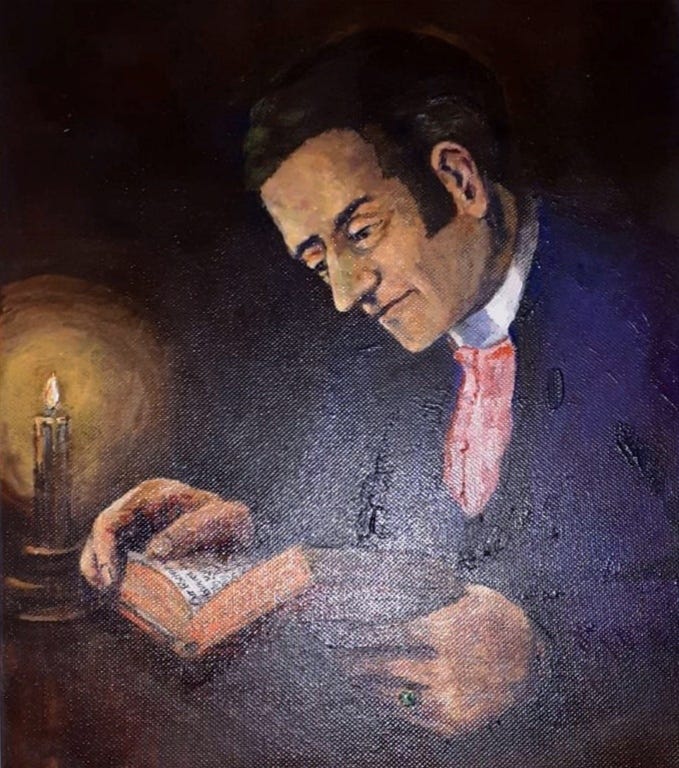
Of particular interest for the purposes of this article is that Dr. Kelly was the Primate who determined to move the episcopal residency from Drogheda to Armagh. Upon the death of the parish priest of Armagh, Fr. James Byrne, in 1834, the archbishop petitioned Rome to have the parish of Armagh as a mensal (i.e. for the maintenance of a Bishop) parish, in addition to that of Drogheda. The petition was granted, but Dr. Kelly died on 13 January 1835 at the age of 43 before he could take possession of the parish of Armagh. The below profile of Dr. Kelly and account of his death is of interest and is taken from the Historical memoirs of the city of Armagh (1900):3
The Primate lived in Laurence Street, opposite the Whitworth Hall. In appearance, he was tall, slender, ascetic-looking and rather stooped, as may be seen from an oil-painting, preserved in the Presentation Convent of Drogheda4. In manner, he was austere and reserved, and was commonly believed to practice great austerity of life. Every morning, he walked down to St. Peter's, where he celebrated Mass. As he glided down Laurence Street and along West Street, bowed in solemn meditation or absorbed in prayer, his stooped, emaciated form at once attracted attention. The people looked on him as a living saint. He was worn to a thread; and, when the doctor, who was called to examine him, after he became un- conscious on the day of his death, opened his vest, he found a coarse hair-shirt next his skin. He died on the thirteenth of January, 1835. His death was caused by the faithful discharge of his duty. In the absence of his priests, he attended a soldier dying of fever in the barracks, and caught the infection which carried him off in a few days. Dr. Murray, archbishop of Dublin, sang the Requiem Mass, and the primate was buried before the High Altar in St. Peter's, West Street. Dying at the early age of forty-three, the Primate was deeply regretted by all classes of people. It is more than probable, that if God had spared him some years longer, he would have begun, at least, some of the great works accomplished by his successors. The inscription on his tomb is as follows:-
EPITAPH OF PRIMATE KELLY.
IN SPEM BEATE RESURRECTIONIS,
HIC JACET
ILLUS ET REVERENDUS DOM. THOMAS KELLY, D.D
ARCHIEPISCOPUS ARMACANUS, TOTIUS HIBERNIE PRIMAS,
COLLEGE APUD MAYNOOTIUM DECAN US POSTEA EPISCOPUS DROMORENSIS, POSTREMO AD HANC SEDEM PRIMATIALEM EVECTUS,
VIR PIETATE ET DOCTRINA ILLUSTRIS.
OBIIT
DIE XIII. JANUARII, MDCCCXXXV.
ETATIS XLIII.
REQUIESCAT IN PACE. AMEN.
IN HOPE OF THE BLESSED RESURRECTION,
HERE LIES THE MOST ILLUSTRIOUS AND MOST REVEREND LORD, THOMAS KELLY, D.D.,
ARCHBISHOP OF ARMAGH, PRIMATE OF ALL IRELAND,
DEAN OF MAYNOOTH COLLEGE;
AFTERWARDS BISHOP OF DROMORE,
FINALLY RAISED TO THIS PRIMATIAL SEE.
DIED
AGED 43 YEARS. MAY HE REST IN PEACE. AMEN.
JANUARY 13TH, 1835.
Dr. Kelly was buried beneath the altar in the ‘old’ St. Peter’s church of 1793 in Drogheda’s West Street. This church was subsequently incorporated into the ‘new’ St. Peter’s which was built in the latter decades of the 19th century. A small plaque commemorating and acknowledging the internment of Dr. Kelly can still be seen today.
29 Laurence Street: The Residence of Dr. Kelly
In the profile above we read that the residence of Dr. Kelly is described as being on ‘Laurence Street, opposite the Whitworth Hall’. Anne Hughes, in a work published in 1892, states that Dr. Kelly “resided in Laurence Street, in the house presently in the tenancy of Dr. Adrian”. Bassett’s Louth Guide & Directory 1886 lists 29 Laurence Street as the address for a Dr. J. W. Adrian5. 29 Laurence Street still exists today, as does the Whitworth Hall, and in the Drogheda volume of the Irish Historic Towns Atlas6, this location and address is given as one which was a Primate's residence (citing Hughes). Taking all of this together, it appears clear that 29 Laurence Street was the residence of Dr. Kelly.
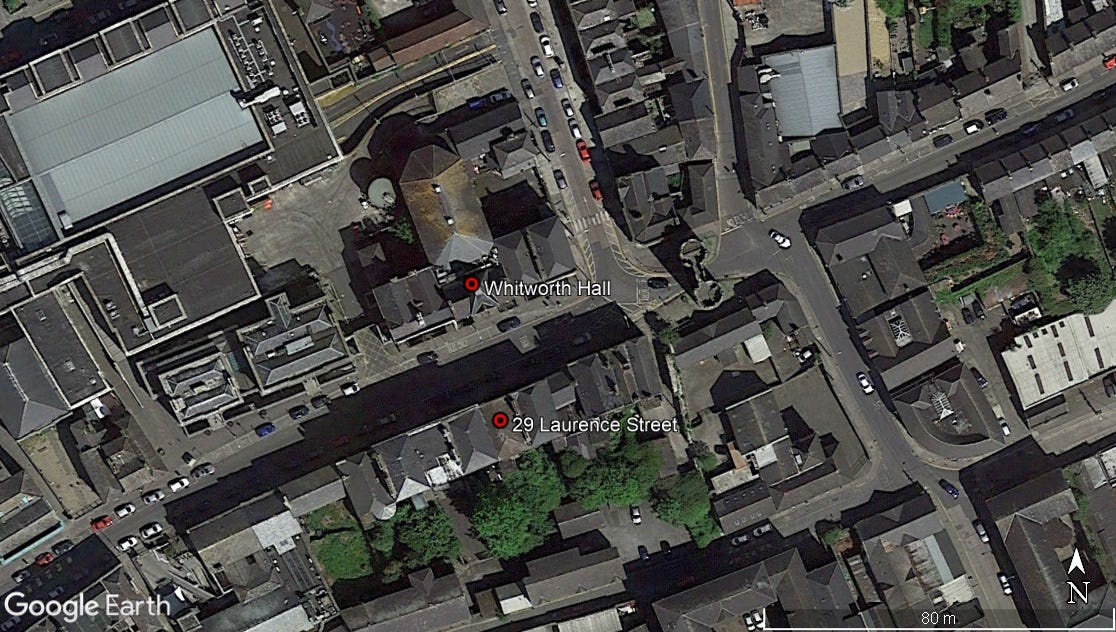
29 Laurence Street is one of a pair of buildings along with no. 28 that would appear to both date from the mid-eighteenth century, or perhaps a little earlier. It should be noted, however, that they are far from being an identical pair, and may be of different dates.
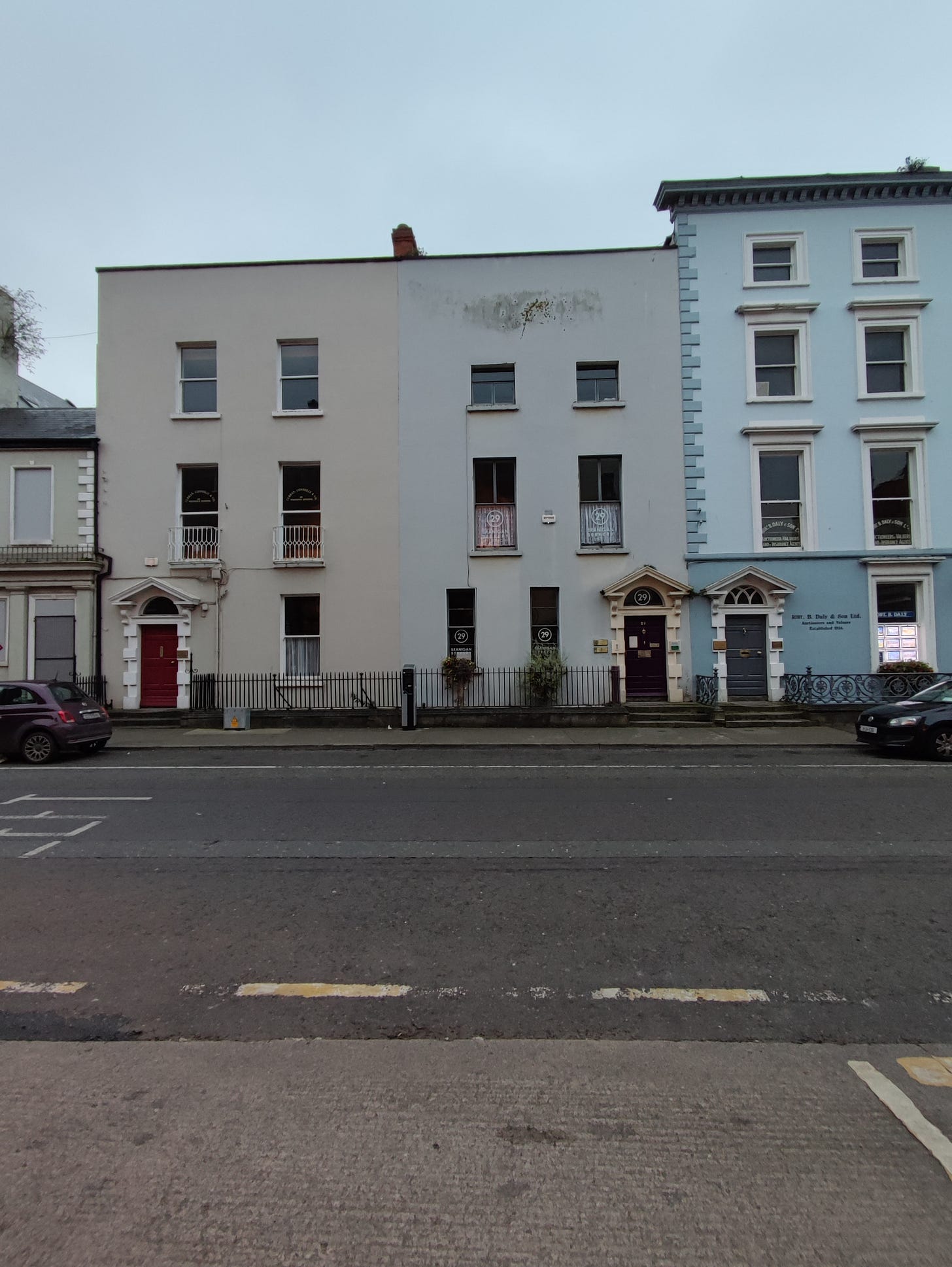
Both are ‘gable fronted’, reminiscent of the ‘dutch billy’ style of building. This is typically characterised by the roof ridge being perpendicular to the front of the building (i.e. in many modern buildings, particularly domestic houses, the gable of the roof is at the side of the house). They do not appear however to have the typical closet return or structural 'corner chimneys’ that define perfect examples of this architectural form.
No. 29 is particularly unusual in that it has a very high gable pediment that protrudes significantly above the roof line. This was likely to make the road-facing height of the building the same as its neighbour, for aesthetic purposes, when they were rendered and modernised sometime in the last 150 years. An examination of early photographs shows us what the buildings looked like prior to this redevelopment; namely their pediments are of differing heights and design and there is no render covering the brickwork.


The design of the roof of each building also differ from one another today, as can be seen in figure 9.
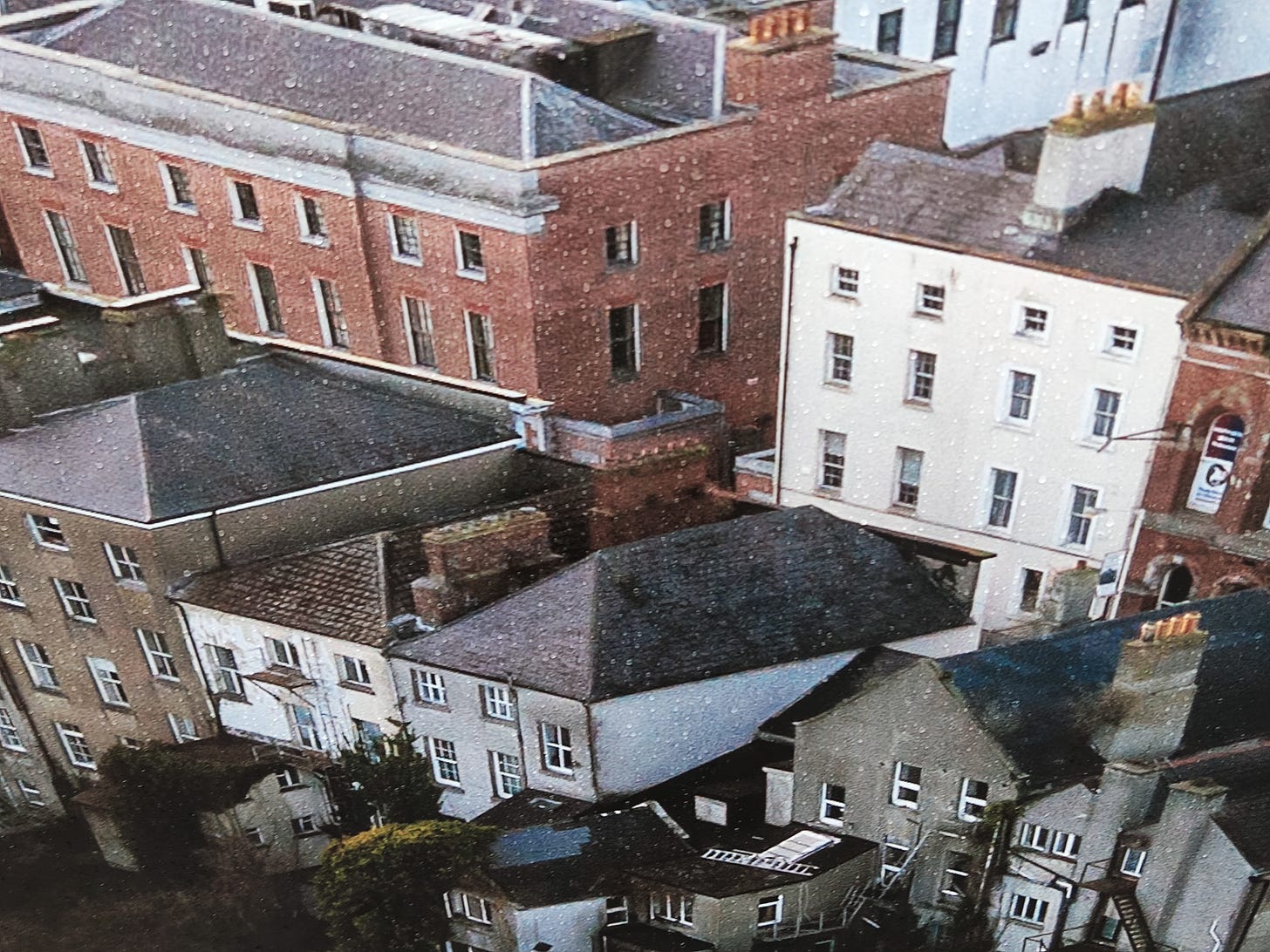
29 Laurence Street is today home to a solicitor’s practice and the building appears to be in reasonable order, adding to the impressive streetscape on one of the most historic streets of Drogheda. Given that it served for a time as a primate’s residence, it is of particular historic and social importance.
Hughes, Anne, Hughes History of Drogheda, pg 69. (Old Drogheda Society, 2003).
The following article is particularly useful in this regard:
Ambrose MacAuley, ‘The Appointments of Patrick Curtis and Thomas Kelly as Archbishop and CoadjutorArchbishop of Armagh’. Source: Seanchas Ardmhacha: Journal of the Armagh Diocesan Historical Society, Vol. 10,No. 2 (1982), pp. 331-365.
James Stuart & Ambrose Coleman, Historical memoirs of the city of Armagh (1900), pg 291-292. Text available here: https://archive.org/details/historicalmemoi00colegoog/mode/2up
I suspect this is the same painting as that in figure 1.
George Henry Bassett, Louth county guide and directory, including the Town and County of the Town of Drogheda: a book for manufacturers, merchants, traders, land-owners, farmers, tourists, anglers, and sportsmen generally. (1886). Available here: https://www.irishfamilyhistorycentre.com/pdf/?product_id=1465
McHugh, Ned, IRISH HISTORIC TOWNS ATLAS, no. 29 DROGHEDA/DROICHEAD ÁTHA, pg 66.




